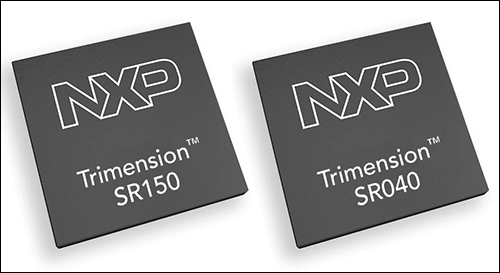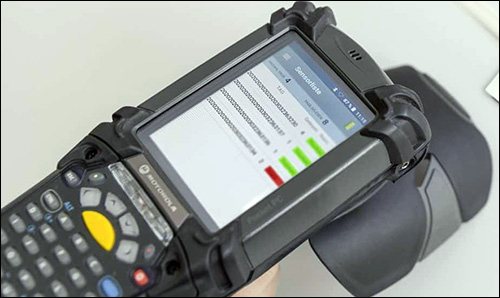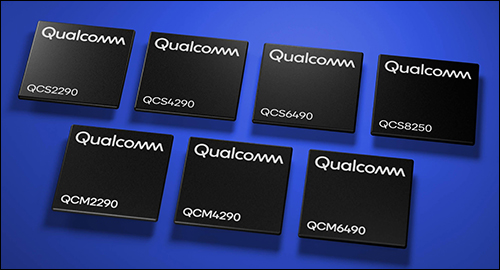Jun 17, 2021Presented here are recent news announcements regarding the following organizations: NXP Semiconductors, Schreiner ProTech, Qualcomm Technologies, SkyLab, Semtech, Event Genius, Terminal V, Energous, Atmosic Technologies and Cupix.
NXP Offers UWB Development Tools for Apple Products
NXP Semiconductors has announced that it now offers beta ultra-wideband (UWB) development tools from its NXP Trimension portfolio that interoperate with Apple's U1 chip. The beta development tools, according to the company, will allow developers to design applications that interact with UWB-enabled Apple products, including iPhones and Apple Watches, enabling them to create precise, directionally aware app experiences.
 With access to Apple's Nearby Interaction protocol and application programming interface, NXP reports, developers will be able to leverage the spatial awareness of UWB to build apps that can communicate with accessories, simply by being in close proximity to a U1-equipped iPhone or watch. The development tools are based on NXP's Trimension SR150 and SR040 UWB-based Internet of Things (IoT) solutions. PHY/MAC operation is handled within the UWB IC in accordance with FiRa Consortium specifications.
With access to Apple's Nearby Interaction protocol and application programming interface, NXP reports, developers will be able to leverage the spatial awareness of UWB to build apps that can communicate with accessories, simply by being in close proximity to a U1-equipped iPhone or watch. The development tools are based on NXP's Trimension SR150 and SR040 UWB-based Internet of Things (IoT) solutions. PHY/MAC operation is handled within the UWB IC in accordance with FiRa Consortium specifications.
NXP also offers tools to access the Nearby Interaction protocol. Murata's UWB Development Kit enables IoT devices to perform localization tasks or create a setup with multiple UWB anchors. And in partnership with MobileKnowledge, NXP provides a UWB Development Kit with an Arduino connector to bring UWB to IoT devices, such as coin-cell battery-powered trackers and tags. Additional tools are planned for release during the coming weeks, the company reports.
"Trimension development tools are now available to help developers unleash the full potential of Apple's Nearby Interaction protocol and API," said Rafael Sotomayor, NXP's executive VP and general manager of connectivity and security, in a prepared statement. "Our curated range of development tools are ready to power the next exciting phase of UWB development, bringing us closer to a world that anticipates and automates to meet our needs."
Schreiner ProTech Intros UHF RFID Starter Kit
With contactless storage and the reading of data playing a vital role in manufacturing and logistics, Schreiner ProTech has announced its ((rfid)) Starter Kit. RFID technology offers multiple benefits compared to conventional barcodes, the company reports, such as large data capacity and wear resistance. Tags can be read from any side, information can subsequently be added, and RFID enables bulk reading since several chips can be read simultaneously.
 However, the company notes, the application of RFID products can also pose a challenge, as the surroundings may impair a chip's functionality. For instance, contact with liquids or metals can lead to reading issues, while metal boxes and steel structures may affect read range. Therefore, Schreiner ProTech says, an environment must be checked to ensure the full performance capacity of an RFID chip.
However, the company notes, the application of RFID products can also pose a challenge, as the surroundings may impair a chip's functionality. For instance, contact with liquids or metals can lead to reading issues, while metal boxes and steel structures may affect read range. Therefore, Schreiner ProTech says, an environment must be checked to ensure the full performance capacity of an RFID chip.
The ((rfid)) Starter Kit provides equipment for testing RFID functionality at a place of deployment. The tests take place over a span of time and, for realistic onsite testing, the technologies are equipped with a pre-programmed database. The kit enables users to run onsite testing; the results can be logged within a short period of time, and the technology can subsequently be analyzed in terms of performance and ease of use.
The Starter Kit can be integrated into a company's existing workflow, the firm reports, and customer-specific needs can be accommodated. Schreiner ProTech can handle onsite installation and conduct RFID technology training. Components of the kit include UHF RFID labels, an RFID TTR printer, a UHF RFID reader, a UHF RFID gate and software.
Qualcomm Unveils New Internet of Things Solutions
Qualcomm Technologies has announced seven new solutions to support the proliferation of IoT devices, for use in a variety of industrial and commercial applications. These solutions are built to meet the needs of the expanding IoT ecosystem, the company explains, in such segments as transportation, logistics, warehousing, video collaboration, smart cameras, retail and healthcare.
"Qualcomm Technologies is uniquely positioned to lead the IoT ecosystem forward with our systems-level approach," said Jeff Lorbeck, Qualcomm's senior VP and general manager of connected smart systems, in a prepared statement. "Along with the recently announced Qualcomm 315 5G IoT modem, these new IoT solutions further exemplify our commitment to driving global digital transformation and providing a portfolio of solutions to transform industrial and enterprise IoT applications to achieve cutting-edge performance and seamless connectivity."
 The QCS8250 is designed to compute AI at the edge, with support for Wi-Fi 6 solutions and 5G connectivity. This system uses Qualcomm's Kryo 585 CPU architecture and AI Engine, plus an image signal processor to support up to seven concurrent cameras with encoding at up to 4K resolution at 120 frames per second. A neural processing unit powers the artificial intelligence, while machine learning allows compute-intensive IoT applications to enable smart cameras, video collaboration, AI hubs, connected healthcare and smart retail. Flexible options are available from third-party vendors.
The QCS8250 is designed to compute AI at the edge, with support for Wi-Fi 6 solutions and 5G connectivity. This system uses Qualcomm's Kryo 585 CPU architecture and AI Engine, plus an image signal processor to support up to seven concurrent cameras with encoding at up to 4K resolution at 120 frames per second. A neural processing unit powers the artificial intelligence, while machine learning allows compute-intensive IoT applications to enable smart cameras, video collaboration, AI hubs, connected healthcare and smart retail. Flexible options are available from third-party vendors.
The QCS6490 and QCM6490 offer global 5G connectivity and Wi-Fi 6E for IoT devices. With the Kryo 670 CPU architecture, this solution is built for industrial and commercial IoT applications, including transportation, warehousing, connected healthcare, logistics management and retail point-of-sale (POS) kiosks. Equipped to support 5G mmWave/Sub-6 GHz and Wi-Fi 6E, these solutions operate with ruggedized handhelds and tablets, industrial scanners, and human-machine interface systems, and are designed to offer reduced latency, dynamic triple ISPs, and edge AI and computing based on sixth-generation AI Engine.
The QCS4290 and QCM4290 come with the Kryo 260 CPU architecture for increased speed and robust on-device performance, in addition to third-generation AI Engine, dynamic camera capabilities and broad connectivity options (LTE Cat13 and Wi-Fi 6-Ready). These solutions are suitable for industrial and commercial IoT applications, the company reports, such as industrial handhelds in logistics and warehousing, as well as security panels and cameras.
Finally, the QCS2290 and QCM2290 feature LTE connectivity and memory support for low power consumption. Equipped with the Cortex A53 CPU architecture, this platform is intended for use with retail POS, industrial handheld, tracking and camera applications. The QCS2290 and QCM2290 baseband chip is pin-to-pin-compatible with the QCS4290 and QCM4290, enabling customers to utilize hardware and software across various IoT devices.
SkyLab Uses Semtech Asset-Management Platform for Prototyping Board
Semtech, a supplier of analog and mixed-signal semiconductors and algorithms, has announced that SkyLab, a provider of wired and wireless sensors and GPS tracking and measuring systems, will utilize its LoRa Edge asset-management platform (LR1110) to develop its small form-factor prototyping board, intended for indoor and outdoor asset management of valuables, vehicles, vessels and containers. The platform extends the prototyping board's battery life, Semtech reports, making the solution suitable for large-scale deployments.
"Semtech's LoRa Edge provides a perfect basis for a high-performance prototyping board," said Remy Sr de Jong, a SkyLab technical director, in a prepared statement. "We believe that with the technological advancements of both SkyLab and Semtech combined, a wide range of new possibilities in the world of LoRa will open up to enterprises, which can lead to faster integration in a variety of applications." The prototyping solution features Semtech's LoRa Cloud Geolocation service's capabilities, enabling it to reduce power consumption by accurately determining an asset's location indoors or outdoors.
Features include a BME280 sensor for temperature, humidity and barometric readings; an LSM303AGR module system-in-package featuring a 3D digital linear acceleration sensor and a 3D digital magnetic sensor; an MCP73831 charging controller with solar power capabilities for projects lacking access to power on the device; WeMos-compatible pins, enabling users to connect several external boards and sensors with WeMos compatibility; and a programmable RGB LED and a micro-USB port, for charging and programming the ATSAMD21G18 microcontroller.
"While asset tracking may sound simple, the management process can be quite costly and tedious for a business," added Marc Pegulu, the VP of IoT product marketing and strategy in Semtech's Wireless and Sensing Products Group, in the prepared statement. "Those seeking cost-effective Internet of Things solutions should look to Semtech's LoRa Edge platform… Our collaboration with SkyLab highlights Semtech's commitment toward developing solutions that keep the customer's return of investment at top of mind, ensuring usability and scalability for future applications."
Scottish Music Event Goes Cashless With Event Genius Payment Tech
Terminal V, an electronic music event brand in Scotland, will now go cashless by deploying technology provided by Event Genius. The brand's five U.K. events will all go cashless, including four 5,000-capacity summer events featuring such techno performers as Patrick Topping, Floorplan, Adam Beyer and Ben Klock. In addition, Terminal V's Halloween festival will deploy Event Genius's egPay cashless technology, with 40,000 fans in attendance. Attendees will be afforded a COVID-19-secure payments experience before, during and after the events, the company reports.

Prior to each event, ticket holders will create an online account to pre-purchase credits, which will replace cash at the festival sites. These credits will be loaded onto an RFID-enabled wristband that they will receive in exchange for their ticket, with which they can then pay for food, drinks and more. Fans can add credits onsite using self-service top-up terminals, as well as reclaim unspent credits after the event has finished. The system is designed to eliminate physical cash, reduce fan-to-staff contact points, speed up transactions by up to 80 percent, and decrease queues and wait times.
"EgPay offers a win-win scenario for Terminal V's fans and organizers," said Reshad Hossenally, Event Genius's founder and Festicket CSO, in a prepared statement. "Without having to worry about carrying money or wasting time waiting in line to be served, Terminal V attendees can enjoy more of the events while the Terminal V team can expect a reduction in cash handling, fan-to-staff contact points and potential virus transmission, as well as a significant boost to their revenues."
Energous, Atmosic Partner on RF Energy Harvesting
Energous, the developer of WattUp, and Atmosic Technologies, a provider of ultra-low-power wireless solutions for the Internet of Things, have achieved interoperability for radio frequency energy-harvesting technology. This interoperability combines WattUp RF-based wireless charging technology with Atmosic's M3 Series chipset, enabling wireless charging from a distance of up to 2 meters (6.6 feet) for a variety of connected solutions in retail, industrial and consumer applications.
Atmosic and Energous are both members of the AirFuel Alliance. Sanjay Gupta, the organization's president and chairman, explained in a prepared statement, "Technological advancements in wireless power, and the development of the interoperability and infrastructure to facilitate broad adoption, require collaboration. The partnership between Energous and Atmosic to bring cutting-edge products to market embodies the spirit of the Alliance. We look forward to AirFuel members continuing to pave the way in innovation for the industry."
Neeraj Sahejpal, Energous's senior VP of marketing and business development, added in the statement, "Atmosic's vision of 'forever battery' life aligns with Energous's vision of wireless charging 2.0 and we're excited to combine our technologies for interoperability to advance at-a-distance charging up to 2 meters. Energous's WattUp transmitter technology is ideally suited for applications in the growing retail, industrial, consumer and IoT sensors markets and allows for more power in a stable, reliable way."
Atmosic's Lowest Power Radio, On-demand Wake Up and Controlled Energy Harvesting technologies enable the M3, based on the Bluetooth 5 standard, to extend battery life and, for some applications, operate without batteries. This lowers maintenance times and cost of ownership for connected device deployments, the companies explain, in addition to reducing the number of batteries that end up in landfills. Atmosic's Controlled Energy Harvesting technology can capture energy from a variety of sources, including ambient photovoltaic, radio frequency and thermal sources, and mechanical sources.
"Energous has been a leading player on the march toward next-gen wireless charging technologies and shares a similar vision with Atmosic to reduce device dependency on batteries," said Srinivas Pattamatta, Atmosic Technologies' VP of marketing and business development, in the prepared statement. "We're eager to combine Atmosic's cutting-edge RF energy harvesting SoC and Energous's WattUp transmitter to open up new possibilities for a wide variety of IoT applications with at-a-distance charging of up to 2 meters."
Cupix Launches 3D Digital Twin Platform
Cupix, which provides 3D digital-twin solutions for the architecture, engineering and construction industries, as well as building owners, has announced the availability of CupixWorks 2. The platform enables building owners, general contractors and project managers to build smarter, the company explains, and to make construction sites easier to manage. Requiring only a consumer-grade 360-degree camera, CupixWorks 2.0 allows users to create and share a 3D digital twin, whether for a simple commercial building, a complex facility or an external infrastructure project, like roads and bridges.
The CupixWorks 2.0 platform includes automated 3D spatial information extraction and editing tools, which enable 3D spatial intelligence-based site management, BIM data support, and secure collaboration and data-access controls. The platform features a redesigned digital twin viewer for easier integration with third-party vendors, the company reports, as well as streamlined LiDAR data support, and drone-mounted 360-image sequence capture and support.
"In a world where surprises and complications are commonplace and costly, our solutions give customers the collaboration, confidence and control they need to stay on time, on budget and on target," said Simon Bae, Cupix's founder and CEO, in a prepared statement. "Cupix is excited to bring our pioneering 3D expertise to market and to empower contractors and owners everywhere to build smart. Our vision goes beyond traditional 3D digital twins or even smart cities. We want to help the world build smarter."
While manufacturing has begun to embrace digital twin technology, Cupix reports, construction has remained largely a 2D industry. With 3D visual digital twin technology, the company adds, offsite personnel can gain access to onsite views of projects. Cupix says its customers have found that 3D digital twin technology makes it easier for them to manage complex projects and identify potential problems before they can occur. According to the company, CupixWorks 2.0 includes customizable, enterprise-ready data-security and access-management tools, multi-cloud storage options for building and design files, and hardware kits and self-service templates that enable quick onboarding for both technical and non-technical users.

